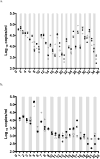Assessment of the low-cost Cavidi ExaVir Load assay for monitoring HIV viral load in pediatric and adult patients
- PMID: 19617845
- PMCID: PMC2784031
- DOI: 10.1097/QAI.0b013e3181b05f62
Assessment of the low-cost Cavidi ExaVir Load assay for monitoring HIV viral load in pediatric and adult patients
Abstract
Background: Viral load (VL) is a critical marker for monitoring HIV disease progression and response to antiretroviral therapy. In resource-constrained settings, there is a need for a simple and inexpensive assay to monitor infected adults and children.
Methods: We compared versions 2 and 3 of the ExaVir Load assay, Cavidi AB (HIV RT) with the Roche, COBAS Amplicor HIV-1 Monitor assay (HIV RNA) for quantifying HIV VL.
Results: The HIV RT version 2 assay showed good sensitivity with detection in 94% of samples with HIV RNA >1000 copies per milliliter. Adult samples were tested using HIV RT version 2 (n = 35) and version 3 (n = 23) assays with plasma volumes of 1 mL (recommended), 0.5 mL and 0.25 mL in comparison with HIV RNA. The HIV RT and HIV RNA assay results were comparable when tested using different volumes. Comparison of results from pediatric samples (n = 27), tested using 1 mL and a smaller volume by HIV RT version 2 were not significantly different.
Conclusions: The HIV RT assay was comparable to the HIV RNA assay with sensitivity approaching that of HIV RNA. Smaller volumes than the recommended 1 mL can be used, improving utility of this assay for pediatric monitoring.
Figures


Similar articles
-
Comparative evaluation of the ExaVir Load version 3 reverse transcriptase assay for measurement of human immunodeficiency virus type 1 plasma load.J Clin Microbiol. 2009 Oct;47(10):3266-70. doi: 10.1128/JCM.00715-09. Epub 2009 Aug 5. J Clin Microbiol. 2009. PMID: 19656978 Free PMC article.
-
Evaluation of a low cost reverse transcriptase assay for plasma HIV-1 viral load monitoring.Curr HIV Res. 2005 Apr;3(2):183-90. doi: 10.2174/1570162053506955. Curr HIV Res. 2005. PMID: 15853722
-
Quantitation of human immunodeficiency virus type 1 viral load in plasma using reverse transcriptase activity assay at a district hospital laboratory in Botswana: a decentralization pilot study.J Virol Methods. 2009 Jul;159(1):93-7. doi: 10.1016/j.jviromet.2009.03.008. Epub 2009 Mar 20. J Virol Methods. 2009. PMID: 19442851
-
The measurement of HIV-1 viral load in resource-limited settings: how and where?Clin Lab. 2007;53(3-4):135-48. Clin Lab. 2007. PMID: 17447649 Review.
-
HIV-1 viral load assays for resource-limited settings.PLoS Med. 2006 Oct;3(10):e417. doi: 10.1371/journal.pmed.0030417. PLoS Med. 2006. PMID: 17032062 Free PMC article. Review.
Cited by
-
Past, present and future molecular diagnosis and characterization of human immunodeficiency virus infections.Emerg Microbes Infect. 2012 Aug;1(8):e19. doi: 10.1038/emi.2012.15. Epub 2012 Aug 22. Emerg Microbes Infect. 2012. PMID: 26038427 Free PMC article. Review.
-
Performance characteristics of the Cavidi ExaVir viral load assay and the ultra-sensitive P24 assay relative to the Roche Monitor HIV-1 RNA assay.J Clin Virol. 2010 Nov;49(3):198-204. doi: 10.1016/j.jcv.2010.07.022. Epub 2010 Sep 15. J Clin Virol. 2010. PMID: 20832356 Free PMC article.
-
Can HIV reverse transcriptase activity assay be a low-cost alternative for viral load monitoring in resource-limited settings?BMJ Open. 2016 Jan 27;6(1):e008795. doi: 10.1136/bmjopen-2015-008795. BMJ Open. 2016. PMID: 26817634 Free PMC article. Clinical Trial.
-
Early detection of HIV infection among Kenyan infants using a reverse transcriptase activity assay.Pediatr Infect Dis J. 2012 Jul;31(7):732-5. doi: 10.1097/INF.0b013e318259bc1e. Pediatr Infect Dis J. 2012. PMID: 22581226 Free PMC article.
-
Optimal Allocation of Gold Standard Testing under Constrained Availability: Application to Assessment of HIV Treatment Failure.J Am Stat Assoc. 2013 Jan 1;108(504):1173-1188. doi: 10.1080/01621459.2013.810149. J Am Stat Assoc. 2013. PMID: 24672142 Free PMC article.
References
-
- Crowe S, Turnbull S, Oelrichs R, et al. Monitoring of human immunodeficiency virus infection in resource-constrained countries. Clin Infect Dis. 2003;37(Suppl 1):S25–35. - PubMed
-
- Rouet F, Rouzioux C. The measurement of HIV-1 viral load in resource-limited settings: how and where? Clin Lab. 2007;53(3–4):135–148. - PubMed
-
- Malmsten A, Shao XW, Sjodahl S, et al. Improved HIV-1 viral load determination based on reverse transcriptase activity recovered from human plasma. J Med Virol. 2005;76(3):291–296. - PubMed
-
- Kamat A, Ravi V, Desai A, et al. Quantitation of HIV-1 RNA levels in plasma and CSF of asymptomatic HIV-1 infected patients from South India using a TaqMan real time PCR assay. J Clin Virol. 2007;39(1):9–15. - PubMed
MeSH terms
Substances
Grants and funding
LinkOut - more resources
Full Text Sources
Other Literature Sources
Medical

